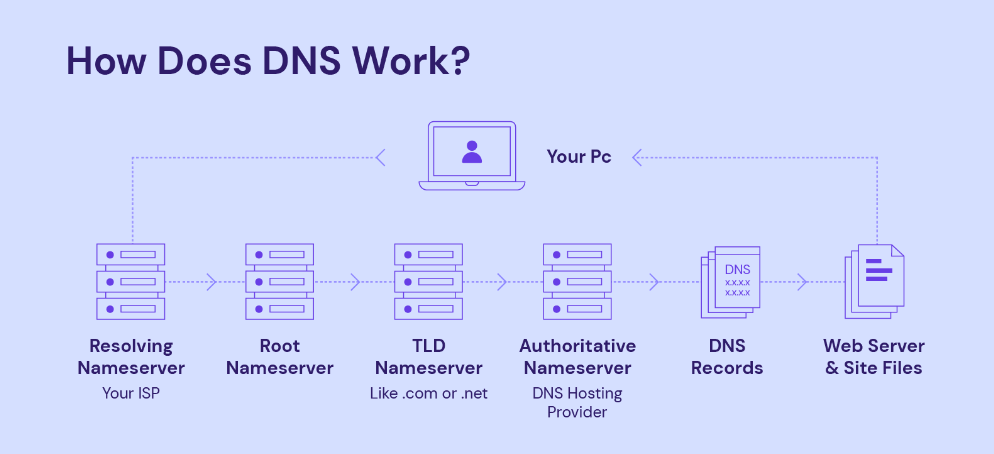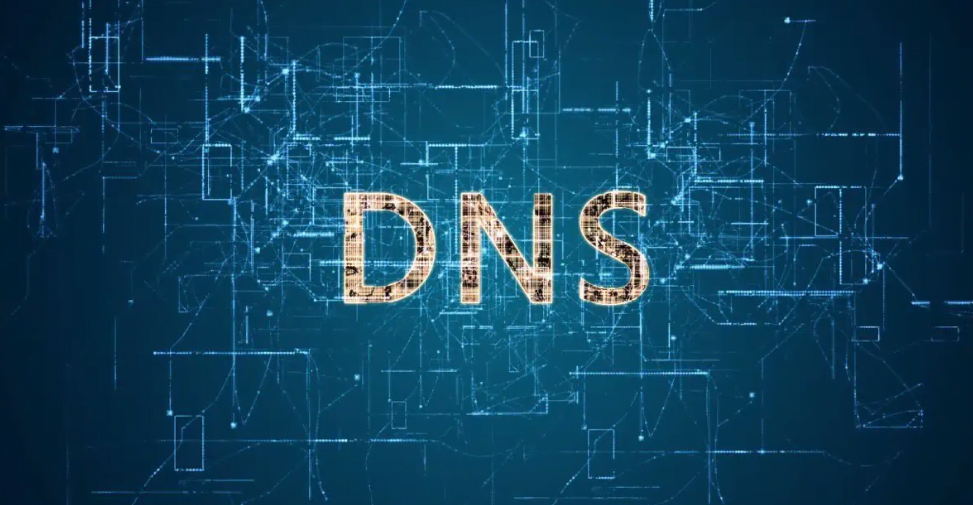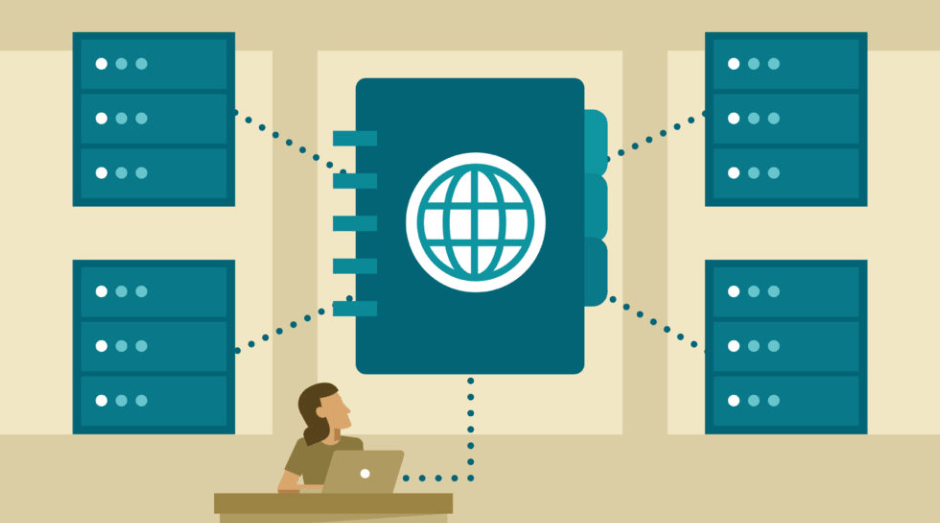As an incumbent in the realm of the Internet, defining what DNS or the Domain Name System is, is imperative. DNS is used by millions of clients all over the world to help the user translate a domain name to an IP address that allows the user to access websites and other related services on the Internet. Hence, in this beginner guide you will be introduced to DNS basics, explain how DNS operates and the various types of DNS servers, why DNS is significant, typical DNS problems, and prospects of DNS’s further evolution.
Understanding the Basics of DNS
At its core, DNS functions as the internet’s directory, allowing people to navigate the vast network with ease. Imagine having to recall and enter a series of numbers for every website you wish to visit; this is what DNS saves you from. Being a vital link in the association of the users to the needed internet content, DNS translates easily recognizable human-readable domain names into machine-readable numeric IPs.
This system is based upon a distribution of duties across various hierarchical levels which contributes to the enhancement of the reliability and efficacy of the procedure of translating domain names to their corresponding IP addresses. Every time you enter a website address into your browser, this initiates a behind-the-scenes process that, although complex, is executed seamlessly thanks to DNS.
The analogy drawn of DNS to be like a phonebook is well suited since the system focuses on the organization of information and where to get it once it is required. However, unlike a phonebook that lists numbers next to names in a static format, DNS is dynamic. It responds to each query with the most current IP address available, ensuring that changes in website hosting or server locations are transparent to the end-user.
This characteristic is most appropriate when it comes to adapting and regularly bringing up Internet connectivity as this depends on some real-time procedures.
In this way, using DNS users get insights into a component of the internet structure that can be considered as a structure that, although remains invisible to the general user, is very necessary in creating the user’s overall experience of the internet. The design offers today’s utilization of the internet, as well as waits for growth and development of the internet which is the basis of the ongoing global network.
How DNS Works: A Step-by-Step Explanation
Upon entering a domain name into your web browser, a complex yet swift sequence of events unfolds, starting with your computer dispatching a query to what is known as a DNS resolver. This specialized server acts as the first point of contact in the DNS lookup process, functioning essentially as an intermediary between the user and the vast DNS infrastructure.
The DNS resolver begins its task by scouring its local cache, storage of recent queries, and their corresponding IP addresses. Should the resolver already possess the information due to a recent request, it swiftly returns the IP address to your computer, significantly speeding up the process. However, if the cache doesn’t contain the needed IP address, the resolver embarks on a quest through the DNS hierarchy to find it.
The journey involves reaching out to a root DNS server, which directs the resolver to a TLD (top-level domain) server specific to the domain’s extension, such as .com, .net, or .org. The TLD server then points the resolver towards the authoritative DNS server, which holds the definitive IP address for the requested domain name.
Upon obtaining the IP address from the authoritative server, the DNS resolver relays this information back to your computer. With the IP address in hand, your browser can now establish a connection to the desired web server, rendering the website’s content in your view. All the same, this entire process is mercifully complex and is accomplished in mere thousandths of a second; it drives home the importance of DNS as one of the mainstays in the functioning of the Internet.
The Different Types of DNS Servers Involved
In the orchestrated world of DNS, a variety of servers play pivotal roles, ensuring that every domain name query is accurately translated into its corresponding IP address. These servers, each with a distinct function, collaborate in a relay race of information retrieval that underpins the DNS process.
Recursive DNS servers, often the unsung heroes, act as the middleman between the end-user and the DNS architecture. When you type a website address into your browser, these servers take on the task of fetching the website’s IP address from other DNS servers. If they don’t already have the answer in their local cache from recent queries, they proceed to inquire further up the DNS hierarchy.
Root DNS servers serve as the top-level guideposts in this hierarchy. With a comprehensive overview of the DNS landscape, they direct queries to the appropriate TLD (top-level domain) servers based on the domain’s suffix, such as “.com” or “.org”.
TLD servers specialize in managing these specific domain suffixes, narrowing down the search by directing queries towards the authoritative DNS servers. These authoritative servers are the final stop, holding the definitive IP address for the requested domain. Such a response lets the recursive DNS server accomplish its task, returning the IP address to the user’s device and helping the browser display the required site.
This circle of interaction between different kinds of DNS servers clearly shows how complex this system is and, thus, it proves the point that DNS is one of the Internet’s main components that makes it work with the speed that allows people to get to the places they need in this giant cyberspace as quickly as it can be done.
Why DNS Matters: Beyond Website Loading
DNS can be considered to be a critical component of a multitude of Internet operations that go far beyond simply getting a site to load. It is very vital in the transmission of emails because domain names in emails are converted to IP addresses so that the communication can get to the right destination.
As for the application of online gaming, DNS is a good source for efficient mapping resulting in a fast connection for the players to the game servers. Without DNS, streaming services depend on IP addresses to stream contents, switching between IPs based on proximity to offer the fastest buffer-less streaming services.
However, the role of DNS does not end here, and is also involved in the realm of security as well. It serves the purpose of the primary barrier against different types of cyber threats. As to DNS filtering, all suspicious requests to get access to malicious websites can be prevented, and thus, no virus traffic or phishing attempts get a chance to affect the particular user. DNS queries have to be accurate since any alterations or redirections can create multiple security issues; thus, DNS requires proper security.
DNS is also used in the operation as well as integration of devices that is the Internet of Things (IoT). With the increase in the Internet connection, it is equally challenging for DNS to handle the devices and establish the appropriate connections between smart devices and their related control servers.
In sum, DNS is one of the important segments for the formation of the Internet structure, as well as serving as one of the fundamental tools for Internet clients and enhancing the reliability and effectiveness of Internet services in various fields. It is unreplaceable within the current digital fabric that helps to sustain and integrate the flow of today’s Internet environment.
Common DNS-Related Issues and How to Solve Them
Navigating the world of DNS is not without its challenges. A common issue that users and administrators experience is DNS cache poisoning in which the attackers replace the cache data with bad IP addresses, hence users are redirected to the wrong site. DNS hijacking, another prevalent issue, occurs when attackers reroute queries to malicious sites without the user’s knowledge. Also, DNS amplification attacks use the DNS protocol to create large traffic out of a small request sent to a certain system thus creating a denial of service.
The following strategies can be taken to respond to these vulnerabilities. Keeping DNS software updated is one of the basic measures that protect against the use by attackers of exploits in the DNS system. It is possible to detect the attack as soon as it starts based on the changes in the DNS traffic.
By using DNS filtering, it is possible to filter the access of known malicious sites hence preventing phishing and malware. Last but not least; implementing DNSSEC offers a second level of affirmation over DNS replies and avoids redirection to the unwanted site. Perhaps, having understood the role of DNS and being informed on what typical DNS threats are, users and administrators would be able to prevent the risks of the listed problems.
The Future of DNS: Trends and Innovations
Taking into account the development of new trends and technologies in the domain of DNS, one can state that the horizon is rather promising to bring DNS to a new qualitative level altogether in terms of security, efficiency, and flexibility. Among these, the integration of encryption protocols like DNS over HTTPS (DoH) and DNS over TLS (DoT) stands out, aiming to safeguard DNS queries from prying eyes and unauthorized alterations.
These protocols contribute to the assurance that all the connections between your device and DNS servers are well secured to offer users a paramount experience in terms of their privacy and security regardless of the region of the world.
DNSCrypt is another one that combines two features: traffic encryption and mutual authentication; therefore, one can safely refer to DNSCrypt as one of the most secure DNS systems. This is a great enhancement especially in preventing miTM and making sure that the DNS responses obtained are from the actual authoritative DNS server.
IPv6 is also considered one of the significant trends, which helps to overcome the shortage of IPv4 addresses and introduces practice to a vastly expanded Internet. IPv6 makes it a lot easier and smoother to route since the connectivity of the devices online is in billions and it is only going to increase in the future.
Also, DNS-SD is turning into one of the widespread approaches, which makes devices in one network discoverable and capable of physically connecting. This is even more crucial in the case of IoT since this determines how several devices communicate with each other.
In all, these novelties are aligning DNS towards the future when it will not only play its role as the telephone directory of the Internet but also protect the Internet users’ privacy and security and provide unimpeded connection.



